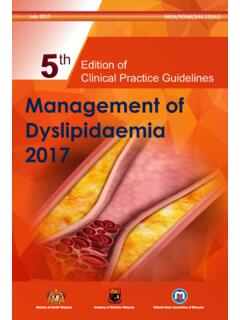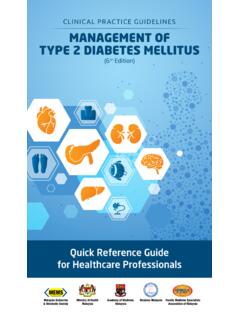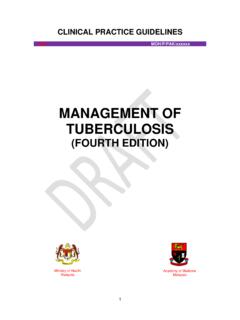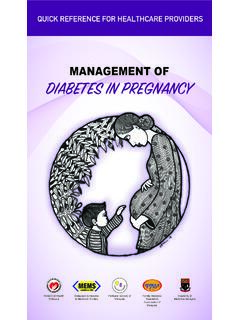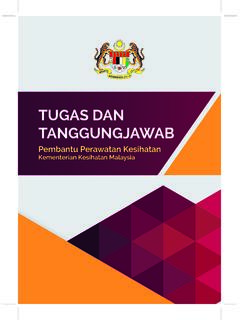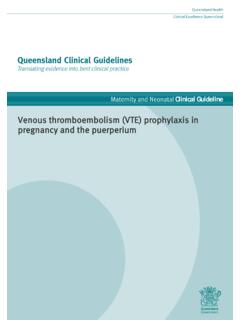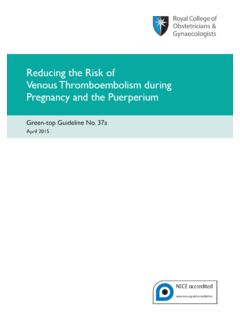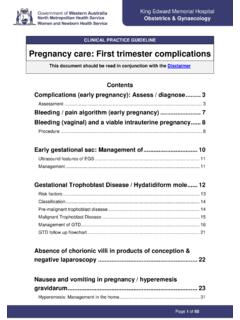Transcription of 2019 MOH/P/PAK/434.19(GU)-e Management of THYROID …
1 clinical PRACTICE guidelines Management OF THYROID DISORDERSiCLINICAL PRACTICE GUIDELINES2019 MOH/P/ (GU)-eManagement of THYROID DISORDERSCLINICAL PRACTICE guidelines Management OF THYROID DISORDERSiiPublished by: Malaysian Endocrine And Metabolic Society (MEMS)Copyright The copyright owner of this publication is MaHTAS. Content may be reproduced in any number of copies and in any format or medium provided that a copyright acknowledgement to MaHTAS is included and the content is not changed, not sold, nor used to promote or endorse any product or service, and not used in an inappropriate or misleading context. ISBN: Available at the following websites: Also available as an app for Android and IOS platform: MyMaHTAS STATEMENT OF INTENT These clinical practice guidelines (CPGs) are meant to be guides for clinical practice, based on the best available evidence at the time of development.
2 Adherence to these guidelines may not necessarily guarantee the best outcome in every case. Every healthcare provider is responsible for the Management of his/her unique patient, based on the clinical picture presented by the patient and the Management options available locally. Every care is taken to ensure that this publication is correct in every detail at the time of publication. However, in the event of errors or omissions, corrections will be published in the Web version of this document, which is the definitive version at all times. This version can be found at the websites mentioned above. UPDATING THE CPG These guidelines were issued in 2019 and will be reviewed in a minimum period of four years (2023) or sooner if new evidence becomes available. When they are due for updating, the Chairman of the CPG or National Adviser of the related speciality will be informed about it.
3 A discussion will be held on the need for a revision, including on the scope of the revised CPG. A multidisciplinary team will be formed, and the latest systematic review methodology used by MaHTAS will be PRACTICE guidelines Management OF THYROID DISORDERSiiiTABLE OF CONTENTKey Recommendations 1 Levels of Evidence 6 Formulation of Recommendation 6 Guideline Development and Objectives 7 Development Group 9 External Reviewers 111. THYROID disorders : THE DISEASE 15 EPIDEMIOLOGY OF THYROID disorders IN MALAYSIA 152. HYPERTHYROIDISM 15 OVERT HYPERTHYROIDISM 15 SUBCLINICAL HYPERTHYROIDISM 303.
4 HYPOTHYROIDISM 38 OVERT HYPOTHYROIDISM 38 SUBCLINICAL HYPOTHYROIDISM 454. THYROID NODULES/GOITRE 47 HOW COMMON ARE THYROID NODULES/GOITRE? 47 WHAT IS THE USUAL clinical PRESENTATION OF THYROID NODULES/GOITRE? 48 clinical EVALUATION OF THYROID NODULES/GOITRE 48 ULTRASOUND EVALUATION OF THYROID NODULES/GOITRE 49 FINE NEEDLE ASPIRATION BIOPSY (FNAB) OF THYROID NODULES 50 LABORATORY EVALUATION FOR THYROID NODULES 52 WHAT OTHER IMAGING MODALITIES MAY BE NEEDED WHEN EVALUATING THYROID NODULES/GOITRE? 53 Management OF THYROID NODULES/GOITRE 535. THYROID EMERGENCIES and PERIOPERATIVE Management OF THYROID DISEASES 55 THYROID STORM 55 MYXOEDEMA COMA 62 PRE-/PERIOPERATIVE Management : HYPERTHYROIDISM 64 PREOPERATIVE Management : HYPOTHYROIDISM 646.
5 THYROIDITIS SUBACUTE & ACUTE THYROIDITIS 65 SUBACUTE THYROIDITIS (DE QUERVAIN S THYROIDITIS) 65 ACUTE/SUPPURATIVE THYROIDITIS 68 clinical PRACTICE guidelines Management OF THYROID DISORDERSiv7. SPECIAL SITUATIONS 70 HYPOTHYROIDISM AND PREGNANCY 70 HYPERTHYROIDISM AND PREGNANCY 73 POSTPARTUM THYROIDITIS (PPT) 81 ACQUIRED HYPOTHYROIDISM AND HYPERTHYROIDISM IN CHILDREN AND ADOLESCENTS 84 THYROID disorders IN THE ELDERLY 1018.
6 DRUG-INDUCED THYROID disorders 108 AMIODARONE-INDUCED THYROID DISEASE 108 OTHER DRUGS THAT CAUSE THYROID DISORDER 1119. GRAVES OPHTHALMOPATHY (GO) 115 WHAT IS THE INCIDENCE OF GRAVES OPHTHALMOPATHY IN MALAYSIA? 115 WHAT IS THE DEFINITION OF GRAVES OPHTHALMOPATHY? 115 HOW IS THE ASSESSMENT OF ACTIVITY AND SEVERITY? 115 WHEN TO REFER TO OPHTHALMOLOGIST AND ENDOCRINOLOGIST? 117 WHAT IS THE TREATMENT FOR GRAVES OPHTHALMOPATHY? 11710. IMPLEMENTING THE guidelines 124 FACILITATING AND LIMITING FACTORS 124 POTENTIAL RESOURCE IMPLICATIONS 124 REFERENCES 125 Appendix 1: clinical Questions 141 Appendix 2: Update Addendum 146 List of Abbreviations 151 Acknowledgement 152 Disclosure Statement 152 Source of Funding 152 clinical PRACTICE guidelines Management OF THYROID DISORDERS1 KEY RECOMMENDATIONSThe following recommendations were highlighted by the guidelines Development Group as the key clinical recommendations that should be prioritised for implementation.
7 HYPERTHYROIDISM In patients with suspected hyperthyroidism, serum TSH and fT4 should be obtained at the initial evaluation. fT3 should be measured when TSH is suppressed but fT4 is within normal range. Patients with overt Graves hyperthyroidism should be treated with any of the following modalities: ATDs, RAI therapy, or thyroidectomy. If ATD is chosen as the primary therapy for GD, the medication should be continued for approximately 12 18 months, and then discontinued if the TSH levels are normal at that time. If surgery is chosen as the primary therapy for GD, near total or total thyroidectomy is the procedure of choice and should be referred to a high-volume THYROID surgeon. Patients with overtly TMNG or TA should be treated with RAI therapy or thyroidectomy.
8 On occasion, long-term, low-dose treatment with MMI may be appropriate. A differential WBC count should be obtained during febrile illness and at the onset of pharyngitis in all patients taking antithyroid medication. Liver function and hepatocellular integrity should be assessed in patients taking MMI or PTU who experience pruritic rash, jaundice, light-coloured stool or dark urine, joint pain, abdominal pain or bloating, anorexia, nausea, or fatigue. HYPOTHYROIDISM Levothyroxine is the recommended preparation of choice and the mainstay of treatment of hypothyroidism. The three main aims of therapy are: i) To provide resolution of signs and symptoms, including biological and physiological markers of hypothyroidism ii) To achieve normalisation of serum TSH with improvement in THYROID hormone concentrations iii) To avoid iatrogenic thyrotoxicosis or overtreatment particularly in the elderly Levothyroxine is best taken on empty stomach (1 hour before breakfast or at bedtime, at least 3 hours after the last meal of the day) because absorption is impaired if taken with food.
9 Compliance may be enhanced however, by instructing patients to consistently take it before breakfast each day. clinical PRACTICE guidelines Management OF THYROID DISORDERS2 Levothyroxine replacement therapy can be started as an initial full replacement or as partial replacement with gradual dose increments titrated using serum TSH as the goal. Dose adjustments should be made when there are significant changes in body weight, and with pregnancy and ageing. Serum TSH should be reassessed 4 8 weeks after any dose adjustments. SUBCLINICAL THYROID disorders When TSH is persistently < mIU/L, treatment of SCHyper is recommended in all individuals >65 years of age. Antithyroid drugs should be the first line and initial treatment for subclinical hyperthyroidism, whatever the aetiology. Radioactive iodine therapy should be considered in those with persistent and progressive subclinical hyperthyroidism due to autonomous nodule and multinodular goitre.
10 Investigation of raised TSH requires repeated measurements to establish a firm diagnosis of subclinical NODULES/GOITRE All patients with a suspected THYROID nodule/nodular goitre or radiographic abnormality suggesting a THYROID nodule incidentally detected on another imaging study should undergo a dedicated THYROID /neck US that encompasses the THYROID as well as the central and lateral neck compartments. Surgery is recommended in: i. symptomatic compression or large goitres (>80 g) ii. relatively low uptake of RAI iii. when THYROID malignancy is documented or suspected ( suspicious or indeterminate cytology) iv. large THYROID nodules, especially if greater than 4 cm or if nonfunctioning, or hypofunctioning on 123I or 99mTc pertechnetate scanning v. coexisting hyperparathyroidism requiring surgery vi.
